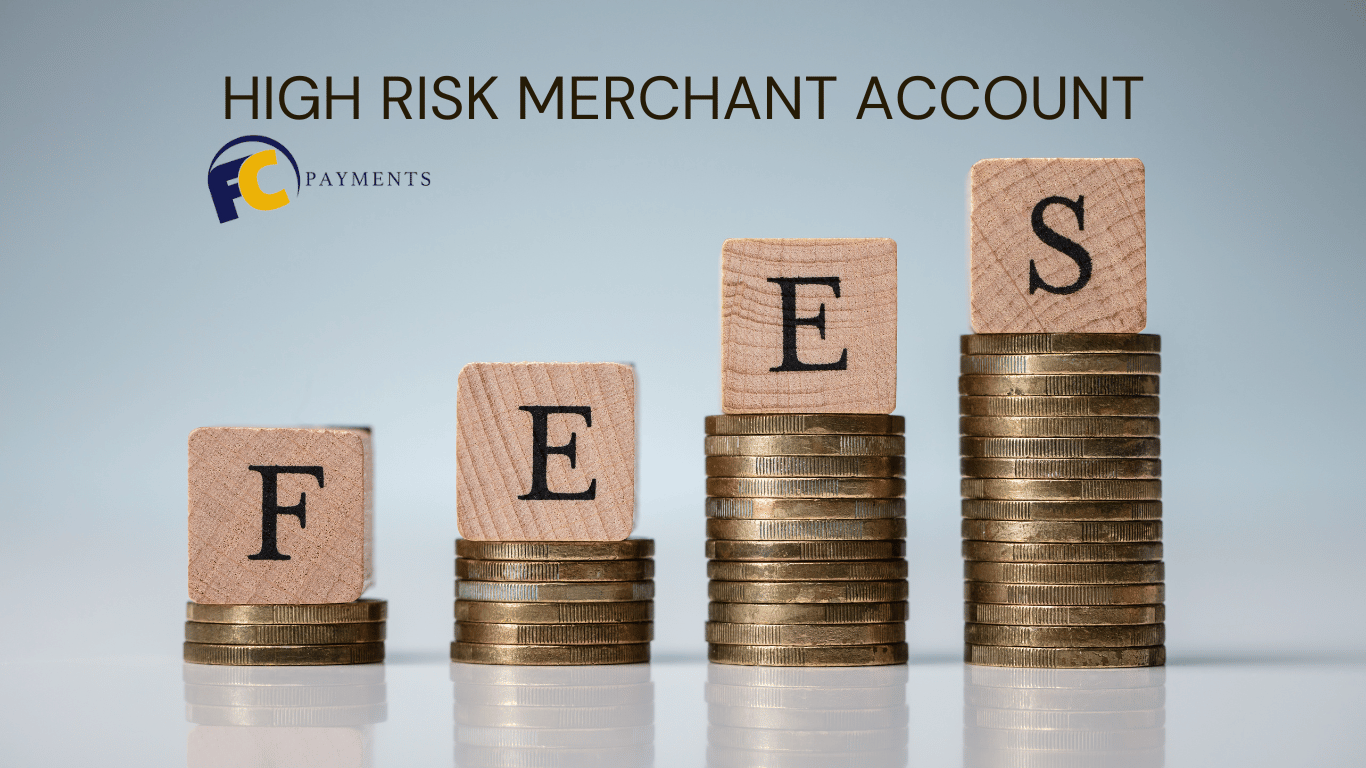
Your Guide to High-Risk Merchant Account Fees & Rates in 2023
If you run a high-risk business, you may have encountered challenges when searching for a suitable merchant account. Merchant accounts can feel complicated to some. Frustration is a common experience.

Average High-Risk Merchant Account Rates
High-risk merchant account rates can vary significantly based on several factors, including the industry you operate in, your business’s risk level, and the payment processor you choose. On average, high-risk merchant account rates fall within the following ranges:
- Transaction Rates: Transaction rates for high-risk merchants typically range from 3% to 10% or higher. These rates are usually higher than those offered to low-risk businesses due to the perceived risk associated with the industry.
- Chargeback Fees: Chargeback fees are levied when a customer disputes a transaction and initiates a chargeback. High-risk businesses often face higher chargeback fees, ranging from $25 to $100 or more per chargeback.
- Monthly Fees: Monthly fees for high-risk merchant accounts can range from $20 to $200 or more. These fees cover the costs of maintaining your account and providing customer support.
- Reserve Accounts: Some high-risk businesses may be required to maintain a reserve account as a precautionary measure. A reserve account is a portion of your funds that is held by the payment processor to cover potential chargebacks or other risks. The reserve amount and terms vary but can range from 5% to 20% of your monthly processing volume.
It’s important to note that these rates are general estimates, and the actual rates you encounter may vary based on your specific business circumstances.
An Overview of High-Risk Merchant Account Fees
To fully understand high-risk merchant account rates, it’s essential to delve into the fees associated with these accounts. Here’s a breakdown of the key fees you may encounter:
Why Are Processing Costs Different for High-Risk Merchant Accounts?
High-risk businesses face elevated processing costs due to the perceived risks associated with their industries. Factors such as chargeback rates, industry regulations, and potential legal liabilities contribute to the higher costs. Payment processors take on additional risks when working with high-risk businesses, resulting in increased fees to mitigate those risks.
Factors that Classify Your Business as High-Risk for a Merchant Account
Several factors can contribute to your business being classified as high risk. Here are some common elements that may result in high-risk categorization:
- Industry Type: Certain industries, such as online gambling, adult entertainment, CBD, and travel, are inherently classified as high risk due to factors like legal restrictions, high chargeback rates, or regulatory compliance challenges.
- Poor Credit History: If your business or the business owners have a history of financial challenges or poor credit, it can raise red flags during the underwriting process, potentially leading to a high-risk classification.
- Chargeback History: High chargeback rates indicate potential issues with customer satisfaction, product quality, or fraudulent activity. Excessive chargebacks are a common reason for businesses to be labeled high risk.
- Reputation and Compliance: If your business has a history of legal or compliance issues, it can contribute to the high-risk classification. Adhering to regulations and maintaining a good reputation are crucial for businesses operating in high-risk industries.
Understanding the factors that classify your business as high risk can help you navigate the challenges associated with obtaining a merchant account and anticipate the related costs.
The Types of Risk Associated with High-Risk Merchants
High-risk merchants face different types of risks, which contribute to the higher processing costs. These risks include:
- Financial Risk: High-risk industries often involve a higher likelihood of financial instability, legal liabilities, and potential loss of revenue due to chargebacks or fraudulent activity.
- Reputation Risk: Businesses operating in high-risk industries may face reputational risks, as their associations with certain industries or customer perceptions can impact their brand image and customer trust.
- Regulatory Risk: High-risk industries are subject to strict regulations and compliance requirements. Failing to adhere to these regulations can result in penalties, fines, or even the termination of your merchant account.
Understanding the types of risks associated with high-risk businesses is essential for managing your operations effectively and making informed decisions.
4 Fees That Fluctuate With Your Risk Level
- Chargeback Fees: Chargebacks occur when a customer disputes a transaction and requests a refund. High-risk businesses typically face higher chargeback rates due to the nature of their industries. Consequently, chargeback fees are often higher for high-risk merchants.
- Transaction Rates: Transaction rates refer to the percentage of each transaction that the payment processor charges. High-risk merchants generally face higher transaction rates compared to low-risk businesses, reflecting the perceived risks involved.
- Monthly Fees: Monthly fees cover the costs of maintaining your merchant account and providing customer support. High-risk businesses may encounter higher monthly fees to offset the additional risks associated with their industries.
- Reserve Accounts: Reserve accounts are a common requirement for high-risk businesses. A portion of your funds is held in a reserve account by the payment processor to cover potential chargebacks or other risks. The percentage and terms of the reserve account can vary based on your risk level.
These fees are dynamic and can fluctuate depending on your risk level and the specific payment processor you choose.
4 Fees That Stay Static Regardless of Your Risk Level
- Refund Fees: Refund fees are charged when you issue a refund to a customer. These fees typically remain the same for all merchants, regardless of their risk level.
- PCI Compliance Fees: Payment Card Industry Data Security Standard (PCI DSS) compliance is mandatory for all businesses accepting credit card payments. PCI compliance fees are charged to cover the costs of maintaining the necessary security standards. These fees are generally the same for all merchants.
- Security Fees: Security fees may be charged to cover the costs associated with fraud prevention measures, data security, and protection against cyber threats. Similar to PCI compliance fees, security fees typically remain constant across different risk levels.
- Termination Fees: Termination fees are charged if you decide to cancel your merchant account before the agreed-upon term. These fees are typically standardized and apply to all merchants, regardless of their risk level.
Understanding these static fees helps you gauge the overall costs associated with your merchant account, regardless of your business’s risk classification.
What to expect as a high risk merchant
As a high-risk merchant, you can expect certain characteristics and challenges that may differ from low-risk businesses. These include:
- Extensive Application Process: High-risk merchant account applications often require more detailed information about your business, including financial statements, marketing plans, and compliance procedures. The underwriting process may take longer due to the increased scrutiny.
- Inflated Payment Processing Fees: High-risk businesses typically encounter higher processing fees compared to low-risk industries. This is due to the perceived risks associated with the industry and the additional measures required to mitigate those risks.
- Revenue Reserves: Some high-risk businesses may be required to maintain a reserve account to cover potential chargebacks or other risks. A percentage of your monthly processing volume is held in this reserve account for a predetermined period.
- Supplemental Requirements and Restrictions: High-risk industries often face additional requirements and restrictions imposed by payment processors or acquiring banks. These can include limitations on transaction volumes, geographic restrictions, or heightened security measures.
Navigating these expectations and challenges requires careful planning, thorough research, and finding a payment processor that specializes in serving high-risk businesses.
High Risk Credit Card Processing Fees Guide

What Is A Normal High Risk Processing Fee?
The “normal” processing fee for high-risk businesses varies depending on the industry, risk factors, and the payment processor you choose. It’s crucial to gather quotes from multiple providers and compare the rates and fees they offer. Remember that the fees should be reasonable and in line with the services provided and the risk factors involved.
High Risk Merchant Fees
High-risk merchant fees encompass various costs associated with payment processing for businesses in high-risk industries. These fees may include transaction rates, chargeback fees, monthly fees, and reserve account requirements. Understanding the breakdown of these fees and their impact on your bottom line is crucial for effectively managing your business finances.
High Risk Payment Processing
High-risk payment processing involves specialized services and solutions tailored to businesses in high-risk industries. These services account for the unique risks associated with these industries and offer the necessary tools to mitigate those risks. High-risk payment processors provide expertise in areas such as fraud prevention, chargeback management, and regulatory compliance.
Lower Your Processing Rates
While high-risk processing rates are generally higher than those for low-risk businesses, there are strategies to lower your processing rates:
- Improve Your Chargeback Management: Implement effective chargeback prevention and management strategies to minimize chargebacks. Maintaining a low chargeback ratio can reduce the associated fees.
- Enhance Security Measures: Invest in robust security measures to mitigate fraud risks. Payment processors may offer lower rates to businesses with strong security protocols in place.
- Seek Competitive Quotes: Don’t settle for the first payment processor you come across. Gather quotes from multiple providers and negotiate for competitive rates based on your business’s unique circumstances.
- Maintain a Good Credit History: Improve your credit history by paying bills on time and managing your finances responsibly. A positive credit history can positively impact the rates and terms offered to your business.
By employing these strategies and working closely with a specialized high-risk payment processor, you can optimize your processing rates and minimize the financial impact on your high-risk business.
Summary

I am passionate about delivering results and helping my clients succeed. With my expertise in SEO, branding, and marketing, I lead the agency’s efforts to create and implement effective strategies that drive business growth. Our all-inclusive approach sets us apart from other digital media companies and ensures that our clients receive the full range of services they need for online success. If you can think of it, we can build it!
Zulu Shack Creative team members thrive on momentum. Like Zulu warriors, we strive to spearhead your idea with speed and quality.
When I’m not helping my team implement new digital marketing strategies, I enjoy playing music, hosting poker nights, reading Stephen King novels, and spending time with my wife and baby daughter.
No Comments
Sorry, the comment form is closed at this time.






